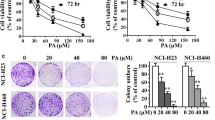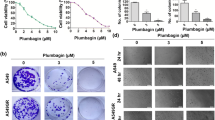Abstract
Introduction
Dihydroartemisinin (DHA), a semi-synthetic derivative of artemisinin isolated from the traditional Chinese herb Artemisia annua, is an effective novel antimalarial drug. Recent studies suggest that it also has anticancer effect.
Purpose
The present study was designed to investigate the effects of DHA on cultured human lung cancer cells (PC-14 cells) to better understand its apoptosis and apoptosis-related factors in vitro.
Methods
The cell viability was measured by MTT assay. The apoptosis induction was examined by DNA ladder and flow cytometry. The intracellular-free calcium concentration in the lung cancer cells were evaluated by laser scanning confocal microscopy with Fura-3/AM as probe. The associated gene expression was examined by Western blot.
Results
After treatment with DHA, a decrease in the viability of PC-14 cells and apoptosis were observed. DHA-induced apoptosis were accompanied by an increase of Ca2+ and activation of p38. Deleted levels of Ca2+ by BAPTA-AM 20 μM or inhibition of p38 by its selective inhibitor SB202190 then led to decreased DHA-induced apoptosis.
Conclusions
These results demonstrated that DHA can induce apoptosis of lung cancer cell line PC-14 cells and calcium and p38 play important roles in the apoptotic signalling pathways.





Similar content being viewed by others
References
Jacobson MD, Weil M, Raff MC (1997) Programmed cell death in animal development. Cell 88(3):347–354
Fadeel B, Orrenius S, Zhivotovsky B (1999) Apoptosis in human disease: a new skin for the old ceremony? Biochem Biophys Res Commun 266(3):699–717
Gerl R, Vaux DL (2005) Apoptosis in the development and treatment of cancer. Carcinogenesis 26(2):263–270
Gordi T, Lepist EI (2004) Artemisinin derivatives: toxic for laboratory animals, safe for humans? Toxicol Lett 147(2):99–107
Singh NP, Lai HC (2004) Artemisinin induces apoptosis in human cancer cells. Anticancer Res 24(4):2277–2280
Efferth T, Dunstan H, Sauerbrey A, Miyachi H, Chitambar CR (2001) The anti-malarial artesunate is also active against cancer. Int J Oncol 18(4):767–773
Berger TG, Dieckmann D, Efferth T, Schultz ES, Funk JO, Baur A, Schuler G (2005) Artesunate in the treatment of metastatic uveal melanoma–first experiences. Oncol Rep 14(6):1599–1603
Susin SA, Zamzami N, Kroemer G (1998) Mitochondria as regulators of apoptosis: doubt no more. Biochim Biophys Acta 1366(1–2):151–165
Nicotera P, Orrenius S (1998) The role of calcium in apoptosis. Cell Calcium 23(2–3):173–180
Zhou YQ, Wang B, Mark E, Chung DH (2006) Oxidative stress-induced intestinal epithelial cell apoptosis is mediated by p38 MAPK. Biochem Biophys Res Commun 350(4):860–865
Lee SK, Jang HJ, Lee HJ, Lee J, Jeon BH, Jun CD, Lee SK, Kim EC (2006) p38 and ERK MAP kinase mediates iron chelator-induced apoptosis and -suppressed differentiation of immortalized and malignant human oral keratinocytes. Life Sci 79(15):1419–1427
Mosmann T (1983) Rapid colorimetric assay for cellular growth and survival: application to proliferation and cytotoxicity assays. J Immunol Methods 65(1–2):55–63
Kotamraju S, Konorev EA, Joseph J, Kalyanaraman B (2000) Doxorubicin-induced apoptosis in endothelial cells and cardiomyocytes is ameliorated by nitrone spin traps and ebselen. Role of reactive oxygen and nitrogen species. J Biol Chem 275(43):33585–33592
Efferth T, Olbrich A, Bauer R (2002) mRNA expression profiles for the response of human tumor cell lines to the antimalarial drugs artesunate, arteether, and artemether. Biochem Pharmacol 64(4):617–623
Huan-huan C, Li-Li Y, Shang-Bin L (2004) Artesunate reduces chicken chorioallantoic membrane neovascularisation and exhibits antiangiogenic and apoptotic activity on human microvascular dermal endothelial cell. Cancer Lett 211(2):163–173
Efferth T, Benakis A, Romero MR, Tomicic M, Rauh R, Steinbach D, Hafer R, Stamminger T, Oesch F, Kaina B, Marschall M (2004) Enhancement of cytotoxicity of artemisinins toward cancer cells by ferrous iron. Free Radic Biol Med 37(7):998–1009
Wu GD, Zhou HJ, Wu XH (2004) Apoptosis of human umbilical vein endothelial cells induced by artesunate. Vascul Pharmacol 41(6):205–212
Zheng GQ (1994) Cytotoxic terpenoids and flavonoids from Artemisia annua. Planta Med 60(1):54–57
Beekman AC, Barentsen AR, Woerdenbag HJ, Van Uden W, Pras N, Konings AW, el-Feraly FS, Galal AM, Wikstrom HV (1997) Stereochemistry-dependent cytotoxicity of some artemisinin derivatives. J Nat Prod 60(4):325–330
Beekman AC, Woerdenbag HJ, Van Uden W, Pras N, Konings AW, Wikstrom HV (1997) Stability of artemisinin in aqueous environments: impact on its cytotoxic action to Ehrlich ascites tumour cells. J Pharm Pharmacol 49(12):1254–1258
Venkatachalam K, van Rossum DB, Patterson RL, Ma HT, Gill DL (2002) The cellular and molecular basis of store-operated calcium entry. Nat Cell Biol 4(11):E263–E272
McConkey DJ, Orrenius S (1997) The role of calcium in the regulation of apoptosis. Biochem Biophys Res Commun 239(2):357–366
Grethe S, Coltella N, Di Renzo MF, Porn-Ares MI (2006) p38 MAPK downregulates phosphorylation of Bad in doxorubicin-induced endothelial apoptosis. Biochem Biophys Res Commun 347(3):781–790
Jiang DJ, Jia SJ, Dai Z, Li YJ (2006) Asymmetric dimethylarginine induces apoptosis via p38 MAPK/caspase-3-dependent signaling pathway in endothelial cells. J Mol Cell Cardiol 40(4):529–539
Petersen C, Svechnikov K, Froysa B, Soder O (2005) The p38 MAPK pathway mediates interleukin-1-induced Sertoli cell proliferation. Cytokine 32(1):51–59
Senokuchi T, Matsumura T, Sakai M, Matsuo T, Yano M, Kiritoshi S, Sonoda K, Kukidome D, Nishikawa T, Araki E (2004) Extracellular signal-regulated kinase and p38 mitogen-activated protein kinase mediate macrophage proliferation induced by oxidized low-density lipoprotein. Atherosclerosis 176(2):233–245
Author information
Authors and Affiliations
Corresponding author
Additional information
Wei Zhang is a co-first author.
The first three authors contributed equally to this research.
Rights and permissions
About this article
Cite this article
Mu, D., Zhang, W., Chu, D. et al. The role of calcium, P38 MAPK in dihydroartemisinin-induced apoptosis of lung cancer PC-14 cells. Cancer Chemother Pharmacol 61, 639–645 (2008). https://doi.org/10.1007/s00280-007-0517-5
Received:
Accepted:
Published:
Issue Date:
DOI: https://doi.org/10.1007/s00280-007-0517-5




